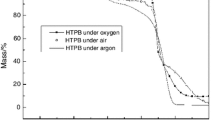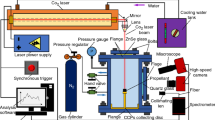Abstract
To investigate the effect of potassium compound on the combustion characteristics of hydroxyl-terminated polybutadiene (HTPB) composite solid propellants. Potassium compound were added to the HTPB propellants as flame inhibitors at different concentration gradients, and the effects of the potassium compound on the thermal decomposition and combustion characteristics of these propellants were investigated by thermogravimetric differential calorimetric scanning calorimetry (TG-DSC) and laser ignition combustion experiments. The results showed that the effect of potassium compound on the thermal decomposition of the HTPB composite solid propellant predominantly occurred in the AP/HMX decomposition stage, and the potassium compound affected the synergistic decomposition of AP/HMX. The entire process of the HTPB composite solid propellant combustion slowed down with increasing potassium compound content; this was mainly shown by the increase in ignition delay time and longer combustion time. The intensity of the secondary combustion flame decreased, the maximum flame area and image grayness decreased, and the intensity of the maximum emission spectrum of the secondary combustion flame decreased. With the increase in potassium compound content, the spectral intensity of free radicals produced by combustion shows a decreasing intensity with a delayed trend with the change rule of time. Overall, the potassium compound weakened the combustion of the HTPB composite solid propellant.








Similar content being viewed by others
References
Mchale ET. Flame inhibition by potassium compounds. Combust Flame. 1975;24:277–9. https://doi.org/10.1016/0010-2180(75)90159-5.
Chen C, Li H, Qin Z, Wang C, Xu Y, Sun Z, Yi J, Zhao F. Development of research on the effect of potassium salt flame suppressant. J Ordnance Equip Eng. 2022;43:99–105.
Rosser WA, Inami SH, Wise H. The effect of metal salts on premixed hydrocarbon—air flames. Combust Flame. 1963;7:107–19. https://doi.org/10.1016/0010-2180(63)90168-8.
Friedman R, Levy JB. Inhibition of opposed jet methane-air diffusion flames. The effects of alkali metal vapours and organic halides. Combust Flame 1963;7:195–201. https://doi.org/10.1016/0010-2180(63)90179-2.
Qi X, Li J, Zhang X, Li X, Zheng W, Liu P. Influence of energetic potassium saltas eliminated-flame additive on performance of nitramine modified double base propellant. Chin J Energ Mater. 2013;21:334–8.
Yim YJ, Jang MW, Park EY, Lee JS, Han H, Lee WB, et al. Infrared irradiance reduction in minimum smoke propellants by addition of potassium salt. Propellants Explos Pyrotech. 2015;40:74–80. https://doi.org/10.1002/prep.201400172.
Wu W, Liu X, Ma Y, Tan W, Qi X. Thermal decomposition and laser ignition of PBX(HMX)/AP composites containing different granularity of HMX. Chin J Explos Propellants. 2022;45:711–21. https://doi.org/10.14077/j.issn.1007-7812.202203004.
Pivkina AN, Muravyev NV, Monogarov KA, Ostrovsky VG, Fomenkov IV, Milyokhin YM, et al. Synergistic effect of ammonium perchlorate on HMX: from thermal analysis to combustion. In: De Luca LT, Shimada T, Sinditskii VP, Calabro M, editors. Chemical rocket propulsion: a comprehensive survey of energetic materials. Cham: Springer International Publishing; 2017, p. 365–81. https://doi.org/10.1007/978-3-319-27748-6_15.
Trache D, Maggi F, Palmucci I, DeLuca LT. Thermal behavior and decomposition kinetics of composite solid propellants in the presence of amide burning rate suppressants. J Therm Anal Calorim. 2018;132:1601–15. https://doi.org/10.1007/s10973-018-7160-8.
Zhou Y, Liu J, Wang J, Xv T, Liang D, Cen K. The formation mechanism and distribution of micro-aluminum oxide layer. J Therm Anal Calorim. 2018;133:1335–44. https://doi.org/10.1007/s10973-018-7174-2.
Babushok VI, Linteris GT, Hoorelbeke P, Roosendans D, van Wingerden K. Flame inhibition by potassium-containing compounds. Combust Sci Technol. 2017;189:2039–55. https://doi.org/10.1080/00102202.2017.1347162.
Hindiyarti L, Frandsen F, Livbjerg H, Glarborg P. Influence of potassium chloride on moist CO oxidation under reducing conditions: experimental and kinetic modeling study. Fuel. 2006;85:978–88. https://doi.org/10.1016/j.fuel.2005.10.021.
Servaites J, Krier H, Melcher JC, Burton RL. Ignition and combustion of aluminum particles in shocked H2O/O2/Ar and CO2/O2/Ar mixtures. Combust Flame. 2001;125:1040–54. https://doi.org/10.1016/S0010-2180(01)00225-5.
Edwards T, Weaver DP, Campbell DH, Hulsizer S. Investigation of high pressure solid propellant combustion chemistryusing emission spectroscopy. J Propul Power. 1986;2:228–34. https://doi.org/10.2514/3.22874.
Xu P, Yuan X, Liu J, Liu H, Zhou J. Effect of α-AlH3 content on ignition and combustion characteristics of multicomponent mixtures. Fuel. 2023;331: 125883. https://doi.org/10.1016/j.fuel.2022.125883.
Jiang H, Bi M, Li B, Ma D, Gao W. Flame inhibition of aluminum dust explosion by NaHCO3 and NH4H2PO4. Combust Flame. 2019;200:97–114. https://doi.org/10.1016/j.combustflame.2018.11.016.
Dounia O, Vermorel O, Jaravel T, Poinsot T. Time scale analysis of the homogeneous flame inhibition by alkali metals. Proc Combust Inst. 2021;38:2371–8. https://doi.org/10.1016/j.proci.2020.06.030.
Author information
Authors and Affiliations
Corresponding author
Additional information
Publisher's Note
Springer Nature remains neutral with regard to jurisdictional claims in published maps and institutional affiliations.
Rights and permissions
Springer Nature or its licensor (e.g. a society or other partner) holds exclusive rights to this article under a publishing agreement with the author(s) or other rightsholder(s); author self-archiving of the accepted manuscript version of this article is solely governed by the terms of such publishing agreement and applicable law.
About this article
Cite this article
Zhao, Y., Liu, J., Gao, H. et al. Study on the effect of potassium compound on the combustion characteristics of HTPB composite solid propellant. J Therm Anal Calorim (2024). https://doi.org/10.1007/s10973-024-13068-w
Received:
Accepted:
Published:
DOI: https://doi.org/10.1007/s10973-024-13068-w




